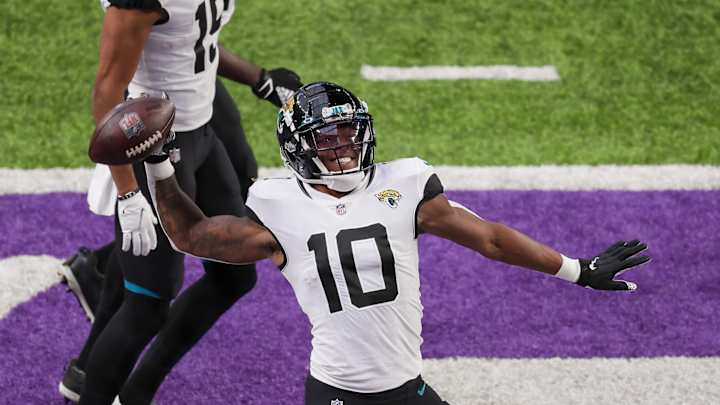Jaguars GM Trent Baalke Breaks Down Shenault, Van Lanen Trades

A year after making several training camp trades, Jacksonville Jaguars general manager Trent Baalke was back to his ways, making a pair of deals this year before the first 53-man rosters were announced: trading away wide receiver Laviska Shenault and adding offensive lineman Cole Van Lanen.
Shenault, who the Jaguars selected with the No. 42 overall pick in the 2020 NFL Draft, was traded to the Carolina Panthers for a 2023 seventh-round selection and a 2024 sixth-round pick.
But why did the Jaguars move on after just two seasons? Baalke explained it was the end of a process that goes all the way back to March, when teams first began calling the Jaguars about their formerly promising young receiver.
“Well, we’ve been fielding calls since free agency when we signed [WR Zay Jones and WR Christian Kirk], we’ve been fielding calls quite a bit," Baalke said on Tuesday.
"Things picked up over the past week and it just came down to a situation where we felt it was a good situation for us as an organization and a good situation for Laviska. We certainly enjoyed him as a player in this organization and wish him nothing but the best.”
As a rookie, Shenault caught 58 passes for 600 yards and five touchdowns on the NFL's worst team. In 16 games last year, however, Shenault caught 63 passes for 619 yards and zero touchdowns, bringing his yards per catch mark down from 10.3 to 9.8 and his yards per target figure down from 7.6 to 6.2. Shenault's catch percentage also took a big hit; after catching 73.4% of his targets in 2020, he caught just 63% in 2021 as Pro Football Reference credited him with eight drop after just three as a rookie.
Shenault played in two preseason games for the Jaguars, catching eight passes for 25 yards. He returned two punts, returning one five yards and fumbling the other. In 30 career games with the Jaguars, Shenault caught 121 passes for 1,219 yards and five touchdowns.
“Yeah, you always want to see guys and see how they would fit into what we’re doing offensively, and [Laviska Shenault Jr.] was a guy that obviously has a skillset that any team would love to have," Jaguars head coach Doug Pederson said. "I wish him the best obviously and it’s a great opportunity for him.”
Aside from trading away Shenault, the Jaguars also made a move last week to trade for Van Lanen, trading a 2021 seventh-round pick for the former Green Bay Packers guard/tackle who has played primarily right guard with the Jaguars during his short time.
Considering the Jaguars released veteran guard/tackle Will Richardson Jr. on Wednesday, the Jaguars' move for Van Lanen could end up paying off quickly in terms of bolstering their offensive line depth.
"We liked him—first of all, it starts with the draft process itself. We liked him when he came out of the University of Wisconsin. He played in a zone system. Wisconsin is a zone-based system. Green Bay is a zone-based system, so it was a good fit that way," Baalke said on Tuesday.
Van Lanen was a sixth-round pick in 2021, with Green Bay selecting him No. 214 after a long career at Wisconsin. He played in 45 games with the Badgers, making 19 starts at left tackle in his four seasons, with 18 of those starts coming over his final two seasons. He Earned first-team All-Big Ten honors from the conference's coaches and second-team recognition from the media as a senior in 2020.
For Baalke and the Jaguars, adding a player with Van Lanen's background for a seventh-round pick is a winning move considering the lack of success of most seventh-round picks. To them, it is like spending a seventh-round pick a year early on a player they think has already performed beyond his draft slot.
"He’s highly intelligent, and he puts together a good tape together, and it was a chance for us to upgrade the roster, so we made the decision," Baalke said.
"When you take a seventh-round pick and draft an offensive lineman, the hit rate is about 20 percent. If he’s already proven that he can step out on the field, you’re taking that seventh-round pick a year early, using it, to us, was a good business decision.”

John Shipley has been covering the Jacksonville Jaguars as a beat reporter and publisher of Jaguar Report since 2019. Previously, he covered UCF's undefeated season as a beat reporter for NSM.Today, covered high school prep sports in Central Florida, and covered local sports and news for the Palatka Daily News. Follow John Shipley on Twitter at @_john_shipley.
Follow _john_shipley